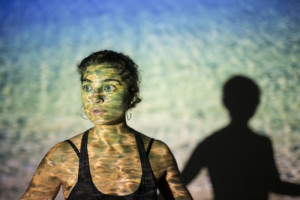Monstrous, or the Miscegenation Advantage, an important piece in undercurrents 2016
 The lights bathe a vast, empty stage. A massive projection screen is mounted along the back. Performer Sarah Waisvisz enters the stage from the audience, singing along with French singer Chantal Goya’s “Adieu les jolis foulards”, a version of the Martinique folk song, “Adieu foulard, adieu madras”. Waisvisz evokes a sense of nostalgia and longing, singing the song out to the audience with open arms. It isn’t until later that the audience will learn the full impact of this saccharine anthem.
The lights bathe a vast, empty stage. A massive projection screen is mounted along the back. Performer Sarah Waisvisz enters the stage from the audience, singing along with French singer Chantal Goya’s “Adieu les jolis foulards”, a version of the Martinique folk song, “Adieu foulard, adieu madras”. Waisvisz evokes a sense of nostalgia and longing, singing the song out to the audience with open arms. It isn’t until later that the audience will learn the full impact of this saccharine anthem.
Monstrous, or the Miscegenation Advantage is in part theatre, in part dance, and in part social provocation from Calalou Productions. It’s a true piece of auto-ethnography, inspired by the artist’s own Ph.D. level research into colonial interference in Caribbean literature. The script finds its footing in creator and performer Sarah Waisvisz’s own story. It is in part Sarah’s personal history as a multi-racial woman who traces her heritage back to the slave coast of West Africa. Here, dance plays a large role as Sarah embodies dance styles that reflect that history. Yet, the script also sets its sights on Sarah’s modern-day, lived experience as someone whose skin colour has been an unavoidable topic of discussion since birth. Waisvisz moves with intention and fluidity on the stage, though sometimes under-vocalizes her lines. Overall, she is dynamic and even a little mischievous.
The production casts a wide net, which mirrors Waisvisz’s reading of her own complex heritage. Given the subject matter, if the play disorients its audience, it is arguably intentional. The audience is positioned as a kind of antagonist; a piece of the puzzle that has Waisvisz longing to find her true home. In fact, Waisvisz goes so far as to point the lens back at the audience, anticipating their apathy to her story. It’s a call to action; Monstrous urges its audience to recognize this apathy as a remnant of a colonial history.
Director Eleanor Crowder has conceptualized a stylistically simple staging for this production. Largely, the staging is a direct address from Waisvisz, though she also adds some chalk-drawings to the bare stage floor—an outline of Africa, and a simple dominant/recessive gene breakdown—which grounds some of the text. Otherwise, the larger-than-life projection screen endows the staging with some complicated moments. At one point, Waisvisz is talking about her own family tree and the Atlantic Slave Trade. Just then, an iconic image of the infamous Door of No Return is projected on the background. Waisvisz watches her shadow approach the door that leads to the vast, open Atlantic ocean that was, conceivably, a point of unfathomable pain for her ancestors. It’s a chilling moment.
The production lingers on a DNA test; a symbol of Waisvisz’s search for definite belonging. The production is dense in its commentary on race, and it is a challenging piece to process, particularly as a white theatre critic. The subject matter, through the lens of this production, has a quiet impact that will stick with its audience. The value of this type of production as part of the undercurrents festival is without measure.